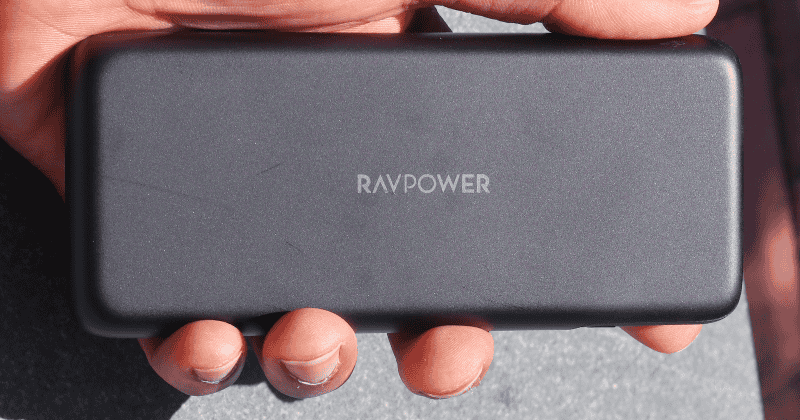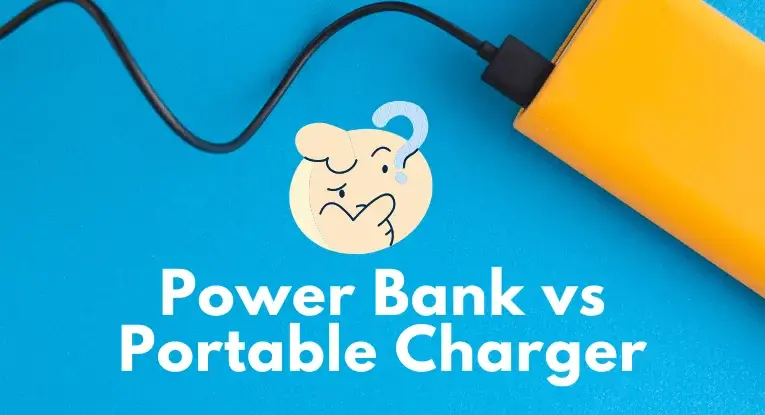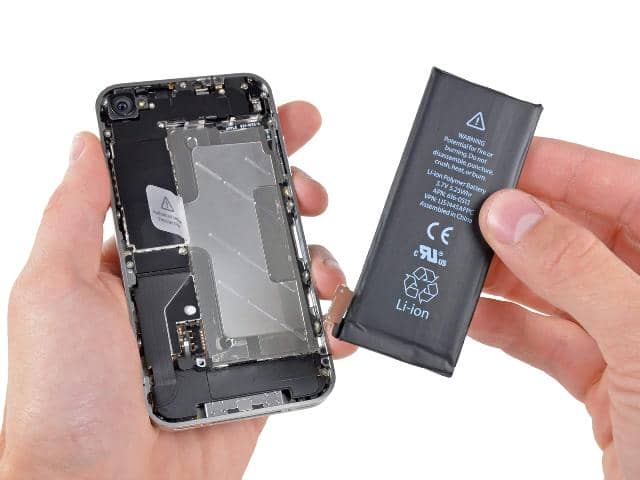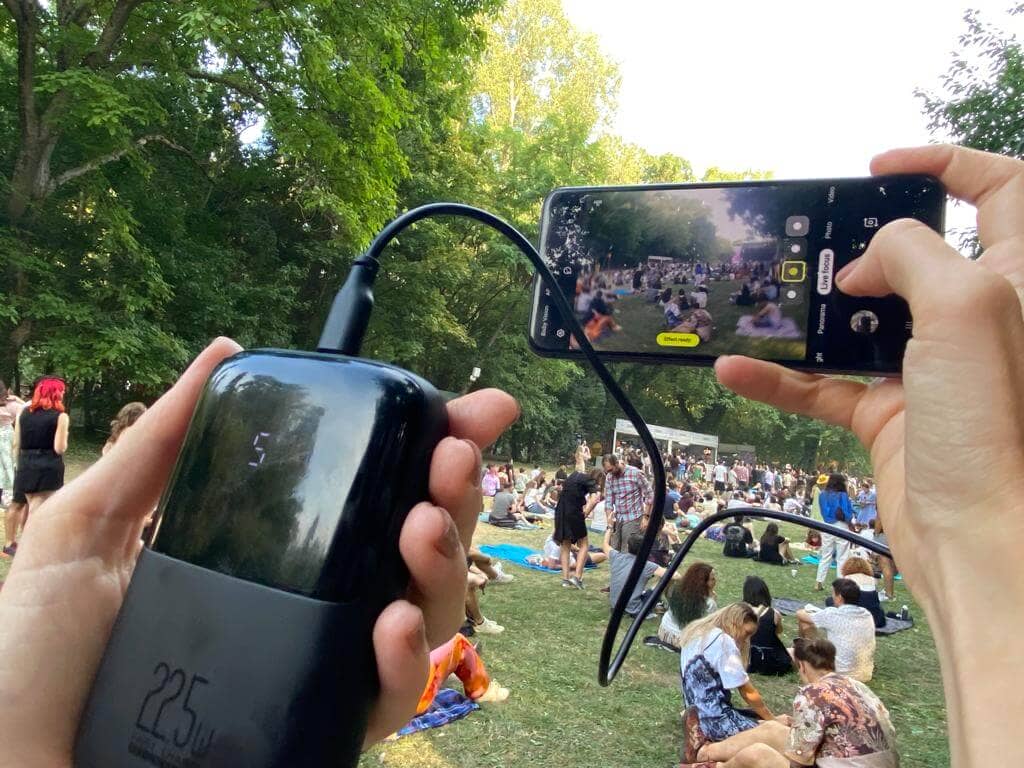Power banks have been getting ever more popular over the last few years. You may have heard people talk about them and you may also have used them in conversation, without knowing too much about them.
In this article, I’ll try to dispel any uncertainty regarding power banks and help you understand them at an above-average level. I’ll also help you understand what to look for when choosing a good power bank for yourself. So let’s get started…
So What’s a Power Bank Anyway?

So the concept of a power bank is pretty simple: a rechargeable battery that can be used to charge other devices. However, even if they seem pretty basic, power banks can have some pretty complex technologies built in.
For example, in order to reduce the risk of malfunctioning, a lot of safety features are added: overcharge protection, over-discharge protection, short circuit protection, etc.
Other types of technologies frequently seen in power banks are pass-through charging, wireless charging, and fast charging technologies such as Qualcomm Quick Charge, Power Delivery, or PowerIQ. Some newer models are even featuring futuristic battery techs such as GaN or Graphene technology.
How Does a Power Bank Work?
Before understanding how power banks work, we should take a look at the main components they have inside:
- Built-in battery: This is the key feature of the power bank. It’s generally a Li-ion battery that will hold the charge as long as needed. The larger the capacity of the battery, the more electrical energy it can store. There are two different measures for capacity: mAh and Wh. Generally, batteries have their capacity size listed in mAh. But if you want to find out their Wh value, you can use a calculator such as this one.
- Internal circuitry: The main role of the internal circuits is to regulate the power flow between the wall charger, battery, and charged devices. In this process, power needs to be transformed in order to meet the requirements of the internal battery and/or the charged device. As a side note, these transformation processes are not perfect, hence the actual power delivered is lower than the capacity of the power bank. More on this subject here.
Other roles of internal circuitry include protecting the power bank from things such as short circuits, overcharging, and over-discharging. They also control the power display and/or LEDs that showcase the amount of capacity that is currently filled up. - Power output ports: Another key component of a power bank is its output ports. These serve as power outlets for your electronic devices and they are usually USB type C, USB type C, or for older models micro USB. However, some power banks can even feature 12V sockets, AC plugs, barrel-type ports, and even cigarette lighter sockets. Power banks have a minimum of one output port, but they can have as many as 7-8 different output ports, especially larger capacity models.
Power banks with more than one port can generally charge multiple devices simultaneously. It’s important to know that ports can provide different voltage values, that can influence charging speeds. Some power-hungry devices, such as laptops, for example, might not get charged at all if the power bank is not able to supply enough power.
Now after understanding the main components at a deeper level, let’s look at the actual process a power bank uses in order to store and then provide power:
- The charging process: Once the power bank is connected to a power source (wall outlet) via a charging brick, the internal circuitry will transform that current to the appropriate voltage and store it in the Lithium-Ion battery.It’s important to mention that the quality of the charging brick matters here. If it can provide all the power needed by the portable charger, it will lead to a fast recharging time. On the other hand, if it provides lower amounts of power than the maximum the portable charger can take, this will lead to slower recharging times.
- Energy storage: Once charged, a power bank can hold the accumulated energy for long periods of time. However, in order to keep the power bank in working condition, most manufacturers recommend having at least a full charge/discharge cycle every 6 months. Otherwise, the stored power might gradually decrease and after a time, the battery life span might be affected once the charge levels drop low enough for long periods of time.
- Providing power: In this stage, the power bank becomes a portable power source for other electronic devices that need charging when classic charging means are lacking. The previously stored energy is released in the connected devices at the exact voltage required.
What Are the Different Types of Power Banks?
Power banks come in many different shapes and sizes to suit different budgets and power needs. There are portable chargers that can be used for just about every device. Most people buy power banks to use them for their cell phones, tablets, or laptops. However, some portable chargers can also be used for devices such as drones, mini-fridges, or even CPAP sleep apnea machines.
New portable charger models are coming out every day with improved charging technologies. Although there aren’t some “official” specific types of power banks, we can still categorize them based on their features and abilities. Here are just a few possible types:
- Universal power banks: the most common type. Simply a battery in a casing shell, with some protection circuitry and some input/output ports. These are the most common portable chargers.
- Solar power banks. These come with a built-in solar charger and can (at least partially!) be charged via solar power. Some solar power banks also have foldable solar panels.
- Thin power banks. These focus on their thinness as a key feature, which gives them the ability to be stored more easily and might fit in tighter places than other power banks. One example of a thin power bank is the Crave Plus.
- High-capacity power banks. When you need to charge more than just your phone, you need a power bank that can supply much more power. For some examples, check out our recommendation list of high-capacity power banks. If you really need a lot of power, you might look into portable power stations, which are basically power banks on steroids.
- Wireless power banks. These offer the option to charge your devices wirelessly via a Qi charging dock. An example would be the Samsung 10000mAh power bank. Others, like the Anker 622 also come with MagSafe which allows the power bank to be attached to the back of any phone that features the same technology.
- Fast charging power banks. There are multiple types of charging technologies, some of thick are faster like PD charging, for example. So if you’re looking for a power bank that charges itself fast and other devices as well, then PD might be a good choice for you. We set up a list of PD power banks here.
How to Charge a Power Bank
All power banks come with a power input port. The type of port can be different based on the model but micro USB was the most popular one until recently. However, micro USB is slowly being replaced by USB type C ports, which seems to be the new standard for the coming years. So, if you’re looking to buy a new power bank, our advice is to look for one with has a USB type C input port. Here’s a curated list of some of the best USB C power banks.
The most efficient way to charge a power bank is to use a wall charger that can deliver a high power output. Using a low-quality wall charger that only delivers 2A for example, can extend the recharging time for several hours. For this reason, we have put together a list of the best GaN chargers and a different one of the best chargers with Quick Charge 3.0 and 4.0. Another way to charge a power bank is by using a charging station.
Other ways to charge a power bank are using your laptop USB port, a car cigarette lighter, or using a solar charger. However, all these methods are slower and you should avoid them unless you can’t access a wall charger.
Make sure to also read our guide on how to use a power bank for the first time.
How Long Does it Take to Charge a Power Bank?
This is largely dictated by the size of the power bank capacity. The larger the power bank capacity, the longer it may take to charge. But other factors can influence the charging speed too, such as the charging technology used. For example, most power banks with fast charging features or those built based on the new graphene or GaN technologies will charge much faster than usual.
As a rule of thumb, for a power bank of 10000mAh, the average recharging time is around 4-6 hours. The fastest ones can charge in under 1h but expect to pay a premium price for that. And the slowest ones might take as much as 8 hours to recharge. It’s best to avoid them if you can find faster-charging options at a similar price point.
How Many Times Can a Power Bank Charge My Device?
This comes down to the capacity of your device and the power bank/portable charger. A power bank is measured by its capacity, which is rated in mAh (milliampere-hour). Generally, the higher the mAh rating of your power bank or portable charger, the more power it will have to recharge your electronic devices. A good rule of thumb is to look at the mAh rating of the devices you want to charge and purchase a power bank that has an equal rating (preferably higher).
For example, the iPhone 11 has a 3110mAh rated battery. The Anker 622 has a capacity of 5000mAh. This would safely charge your phone back to 100% battery. However it is not an exact science, there are factors to consider such as the power bank’s efficiency rating and the condition of the battery in the device you are charging. Read more about the real battery capacity of a power bank.
The following set of figures can be used as a rough guide to what kind of recharging capacity a power bank may give you.
Device Charge Times Example
| Power Bank Rating | Mobile Phone | Tablet |
| 2500mAh | Approx. 1 full charge | Approx. 25% |
| 5200mAh | Approx. 2 full charges | Approx. 50% |
| 10000mAh | 4 full charges | At least 100% full charge |
On our product review pages such as the RAVPower 20000mAh PD 60W, we even have an automatic calculator that can tell you exactly how many times that specific power bank can charge your specific smartphone model:
Charging capacity calculator
Use the search bar below and find out exactly how many times can the RAVPower PD Pioneer 20000mAh charge your smartphone battery

If you don’t know which power bank you want, then you can use our general mAh calculator.
We’re discussing also this subject in more detail here: How many mAh do you need to charge your phone?
Is a Power Bank and a Portable Charger the Same Thing?

YES! They are basically one and the same thing 😊
Different terms such as power bank, portable charger, portable phone charger, external battery, external battery pack, etc. all refer to the same type of device. If it’s a battery that you can use to power a device with its own battery without using a wall socket, it’s a power bank.
Read more about these two terms and their popularity in our dedicated article: Power Bank or Portable Charger?
What Type of Batteries Do Power Banks Use?

Power banks generally come with either Lithium-Polymer (Li-Po) or Lithium-Ion (Li-Ion) batteries. Of the two Lithium-Ion power banks are more popular.
In terms of differences between these two types:
- Lithium-polymer batteries have a higher energy density but they tend to have a shorter lifespan and are also more expensive to manufacture. They’re also less prone to explosion.
- Lithium-ion batteries, on the other hand, have a slightly lower energy density but they can withstand more charge/discharge cycles and are generally less expensive.
For a more in-depth look at this subject, check out our article: Lithium-ion vs Lithium-polymer power banks. Which is better?
Are You Allowed to Take Power Banks on Flights?

Yes, you can take most power banks and other batteried on flights, however, some conditions apply:
- you can only take them in your cabin luggage
- the battery should be 100 Wh or under
- batteries that are between 100 Wh and 160 Wh need a special permit
- ideally, the output should be clearly labeled on the device
Read our detailed article for more information about power banks on flights.
Are Power Banks Bad for Your Phone? Can They Damage the Battery?
Under normal circumstances charging a phone with a power bank will not damage the battery. In fact, it should have the same effect as charging your phone via its conventional charger.
For the phone, it does not matter which power source you use as long as the current is within the admissible limits. You can even charge the phone directly via solar panels as long as the power is stable and has the right values. Smartphones require a 5V input to get charged. So as long as the device you’re charging them with delivers that output, you don’t need to worry.
Power banks deliver at least 5V of power, but in some cases, they can deliver more than 5V too. For example, some power bank models can deliver up to 20V if needed as in the case of charging laptops. But even if the power bank can deliver more than 5V of power, you still shouldn’t worry as both the power bank and the phone have power regulating circuits, that allow the mobile to only take 5V and not more. However, should the charging regulating circuit fail, then you could indeed see a negative impact on the phone’s battery.
Think of the power bank as a tank or reservoir from which the smartphone can draw power. The power reservoir cannot forcefully feed power to the phone. Thus you need not worry that power banks damage your battery.
Top 10 Reasons to Buy a Power Bank
#1 For Traveling
Long gone are the days of traveling with nothing but a change of clothes, toiletries, and accessories. We love to travel here at Power Bank Expert – my backpack right now contains the following electronic goodies: MacBook Pro, Kindle Paperwhite, Olympus 4/3 digital camera, JBL portable travel speaker, iPod Touch, Nexus 5, and an iPad Air.
Traveling is all about the journey, and that often means spending a long time on a train/plane/bus/car. Not to mention waiting around at airports, bus stations, and train stations. More often than not you might not have any access to a PowerPoint to recharge your devices. A power bank will solve your flat battery blues.
Luckily today’s portable power banks come in some truly travel-friendly sizes. Take the Xcentz 5000mAh. Weighing in at a measly 4.5oz, and measuring only 4.8 x 1 x 1in, it really is lipstick-sized. Small enough to slip in your pocket, this portable charger will not put a big dent in your backpack or suitcase.
#2 For Playing Mobile Games
One thing all these mobile games have in common – is their capacity to kill your cell phone’s battery! But avid gamers don’t only use phones for gameplay time, but dedicated consoles such as the Nintendo Switch. However, most power banks are more than capable of satisfying even the most power-hungry consoles and extend the game time for hours on end.
#3 For Portability
Many people do not realize how small portable power banks and phone chargers are. Many are small enough to fit in a pocket or purse. With pretty much all but the most industrial-strength devices being portable enough to fit in a backpack or shoulder bag.
- The Poweradd Slim2 5000mAh weighs just 4.4 oz and measures 3.93 x 1.27 x1.20 inches. This will slip into your pocket with ease.
- A slight step up in size – the Anker Astro E1 5200mAh Candy bar-sized Ultra Compact Portable Charger is an excellent choice. They weren’t lying when they named it ‘candy bar sized’ – it weighs in at 4.2oz, and measures just 5 x 3.4 x 1.7 inches.
#4 For Commuting
I used to have a 1.25-hour train ride to and from work every day, and boy do I wish I’d owned a portable power bank back then! When you’re packed onto a train or a bus, your options are pretty limited in how to kill time. But having your smartphone/tablet/laptop with you can make that journey absolutely fly by. Owning a portable power bank means you can catch up on Game of Thrones, browse Facebook, or read the latest news – and NEVER run out of battery.]
#5 For Camping/hiking/fishing
There’s nothing better than escaping into the great outdoors, but what if you want to stay connected to the digital world whilst you’re enjoying all that nature has to offer? You might want to upload your pictures to Instagram, keep your portable speaker playing tunes, or recharge your camera’s batteries. Here’s where a power bank can come into its own.
Any portable power bank or phone charger would fit the bill for a trip into the great outdoors, but there are some power banks that are purpose-built for the task. The Novoo Explorer 10000mAh is snowproof, dirtproof, drop-proof, and waterproof. Its rugged construction makes it an ideal buy if you often head outdoors.
Or why not keep your electronics charged, and be environmentally friendly at once and buy a solar portable charger? The Nekteck 20W Solar Charger folds out and can be hooked to your backpack as you hike to recharge its batteries straight from the sun. It’s extremely durable, weighs 20oz, and when folded down it measures 11.8 x 6.5in.
#6 FOMO
FOMO or Fear of missing out is an emotion you’ve probably experienced before. And FOMO can quickly turn from fear to reality if you’ve run out of battery! If your cell phone is flat you could miss a call about that important job you just applied for. Or maybe a cute guy/girl just sent you a message on Tinder – how to reply if you have no batteries? Eliminate electronic FOMO and buy a power bank!
#7 For Your Hip Pocket
In this post, we’ve listed all kinds of reasons and benefits why you should buy a power bank. But a really, truly fantastic reason is that they are so affordable! You can buy a high-quality portable power bank from a reputable brand for as little as $10 US. That’s cheaper than
- Getting a haircut
- Going out to dinner
- Buying a bottle of wine
#8 For Music Festivals

There’s nothing much more fun than a multi-day music festival, camping with your friends, and watching your favorite bands play. Keeping your batteries charged means you can find your friends when you inevitably lose each other, keep playing music back at your tent once the bands are finished for the night, and keep posting pictures and videos to make all your friends jealous. Make a power bank an essential travel companion for this summer festival season!
#9 For Your Job
Apart from being super-handy in your personal life, power banks may well be incredibly helpful for your working life as well. Here are a few careers that will really benefit from the purchase of a power bank:
- Photographers can keep their camera’s batteries juiced up when they’re out on a shoot.
- Real estate agents are constantly driving all over their hometowns, showing clients properties, and are always on their phones.
- A job in sales often involves significant amounts of travel, as well as heavy use of laptops/phones/tablets.
- People working in trades such as plumbers, electricians, and plumbers need to drive from job site to job site and are often away from sources of power for long stretches of time.
- Small business owners need their cell phones to keep their businesses running. Being the owner often necessitates significant amounts of travel.
- Students also need electronic devices for their studies. Having your laptop go flat whilst taking notes in a university lecture could really set you back. A power bank will make that a problem of the past!
#10 For Safety
Cell phones have become indispensable in today’s world. A benefit of your cell phone you might not have taken into consideration is your own personal safety. Your phone is your link to the outside world. Consider you’re walking home alone at night and you’re being followed by an unsavory-looking person. This can be a scary situation, and could potentially be very dangerous. All it takes is one call to the police, or to a friend or family member and they can come to help you.
Now consider that scenario again, and imagine your cell phone’s battery is dead! There’s no way for you to contact anyone for help, and that’s a situation I know I would not like to be in. With a power bank or phone charger, you can make sure your cell phone’s battery is ALWAYS topped up.
Power Bank Reviews
If you’re interested in comparing different power bank models, head on to our power bank review section. For a more in-depth article on how to choose the best power bank for you, check out our buyer’s guide.
